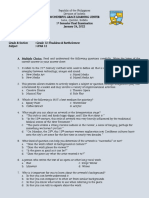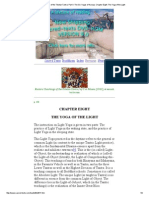Unit Test in Contemporary Arts
Unit Test in Contemporary Arts
Uploaded by
Kristel Gail Santiago BasilioCopyright:
Available Formats
Unit Test in Contemporary Arts
Unit Test in Contemporary Arts
Uploaded by
Kristel Gail Santiago BasilioOriginal Description:
Original Title
Copyright
Available Formats
Share this document
Did you find this document useful?
Is this content inappropriate?
Copyright:
Available Formats
Unit Test in Contemporary Arts
Unit Test in Contemporary Arts
Uploaded by
Kristel Gail Santiago BasilioCopyright:
Available Formats
CONTEMPORARY PHILIPPINE ARTS FROM THE REGION
_____1. It is creating something new, something original and something different on a material and making inanimate objects to have life.
A. Art B. Aesthetic C. Rhythm D. Balance
_____2. Which principle will you apply when there is an alteration of black and white stripes, by checkered blue and orange squares?
A. Art B. Aesthetic C. Rhythm D. Balance
_____3. Ariane is a fine arts student while studying she learns to admire the artists, value highly different works of art, and appreciate the role of art
in society. What division of art study is does Ariane possess?
A. Contemporary Art B. Integrative Art
C. Art Appreciation D. Art Production
_____4. John is an artist by heart and soul which is really evident through his art works. He contributes to the growth and development of the
Philippine Arts. He also has an outstanding share in the cultural heritage and cultural identity of the country. If you will assess, what award will he
can be received?
A. Order of the National Artist Award B. National Living Treasures Award
C. Notable Contemporary Artist Award D. None of the above
_____5. This award recognizes the artist that preserves the traditional art of the Philippines which kept the art alive even in the contemporary period.
A. Order of the National Artist Award B. National Living Treasures Award
C. Notable Contemporary Artist Award D. None of the above
_____6. There are different periods in the art history which reflects our rich culture and artworks. Nowadays, our art is presently called
Contemporary arts, when did contemporary arts begin?
A. Art which are developed from 1960 until now
B. Art which are developed from 1970 until now
C. Art which are developed from 1980 until now
D. Art which are developed from 1990 until now
_____7. The following are the reason why people engaged in art, EXCEPT;
A. to express their emotions and thoughts, real or imaginary
B. to entertain, informs, and persuades people
C. to produce things of beauty and masterpieces
D. to give them privacy
_____8. Based on Philippine art history, arts are for ritual purposes or for everyday use. What era is this which is also known as ethnic art?
A. Pre-Colonial B. Spanish C. American D. Islamic
_____9. What era does characterize by geometric designs and patterns eliciting focus from the believers?
A. Pre-Colonial B. Spanish C. American D. Islamic
_____10. What era does art became handmaiden of religion to propagate the Catholic faith and thus support the colonial order at the same time?
A. Pre-Colonial B. Spanish C. American D. Islamic
11-15. Direction: Write E if the statements belongs to Ethnic Tradition, S if it belongs to Spanish Tradition, A if it belongs to American Colonial
and Contemporary Traditions.
_____11. Filipino developed choreographies by mimicking movements of animals.
_____12. Technological innovations affected art making resulting to non-conventional artworks.
_____13. Zarzuelas and operas became popular in this period.
_____14. Religion and secularization influenced all art forms.
_____15. Pottery, weaving, wood carving, and metal crafting are the forms of visual arts.
16-20. Direction: Analyze the following artwork. Identify what are the principles of art used in the artwork and choose the best answer from the box
below. Write the letter of your answer on the blanks provided and use CAPITAL LETTER only.
A. Harmony B. Balance C. Rhythm
D. Proportion E. Emphasis F. Radial
_____16. _____17. _____18.
_____19. _____20.
21-30. Direction: Identify the artworks of the different National Artist of the Philippines. Match the Column A from Column B. Write the letter of
your answer on the blanks provided and use CAPITAL LETTER only.
_____21. Fernando Amorsolo A. UP Oblation
_____22. Vicente Manansala B. Manila Polo Club
_____23. Guillermo Tolentino C. Ang Probinsyano
_____24. Pablo Tinio D. Walang Sugat
_____25. Carlos Quirino E. Planting Rice
_____26. Lino Brocka F. The Great Malayan
_____27. Ronald Alan Poe G. A Cluster of Nipa Hut
_____28. Ernani Cuenco H. Philippine Folk Dances and Games
_____29. Daisy Avellana I. Inang Bayan
_____30. Francisca Reyes Aquino J. Tinimbang Ngunit Kulang
You might also like
- Sebastian Crows Guide To DrakkenheimDocument244 pagesSebastian Crows Guide To DrakkenheimJames Deming100% (19)
- 1st Periodical Exam in CPAR ANSWER KEYDocument3 pages1st Periodical Exam in CPAR ANSWER KEYRS Dulay75% (8)
- Contemporary Midterm ExamDocument5 pagesContemporary Midterm ExamSheenLibarnesYparraguirre100% (5)
- Cpar Nat'l Artist Summative TestDocument4 pagesCpar Nat'l Artist Summative TestIekzkad Realvilla100% (1)
- Contemporary Arts 12. 1ST Quarter Summative Test - MDMDocument5 pagesContemporary Arts 12. 1ST Quarter Summative Test - MDMmarilyn monfero80% (5)
- 1st Quarter Exam in Contempo..Document2 pages1st Quarter Exam in Contempo..May-Ann S. Cahilig100% (9)
- Pre Test in CPARDocument2 pagesPre Test in CPARJeffReyT.Ausan100% (4)
- Final Exam Contemporary ArtsDocument2 pagesFinal Exam Contemporary ArtsGlenda Ortillano Lee90% (10)
- Lesson 1: Who Is Trainer And/or Assessor?: Plan Training SessionDocument32 pagesLesson 1: Who Is Trainer And/or Assessor?: Plan Training SessionKristel Gail Santiago Basilio100% (2)
- Novo MunayDocument12 pagesNovo MunayAntonio Enrique VilaNo ratings yet
- Egyptian YogaDocument3 pagesEgyptian YogaSolomanTrismosinNo ratings yet
- Gregory Schopen - If You Can't Remember, How To Make It Up: Some Monastic Rules For Redacting Canonical TextsDocument12 pagesGregory Schopen - If You Can't Remember, How To Make It Up: Some Monastic Rules For Redacting Canonical TextsƁuddhisterie2No ratings yet
- Contemporary Philippine Arts From The Regions ScoreDocument4 pagesContemporary Philippine Arts From The Regions ScoreConje JessaNo ratings yet
- Midterm CaDocument4 pagesMidterm CaMay MayNo ratings yet
- Final Exam in Cpar 2018-2019Document3 pagesFinal Exam in Cpar 2018-2019Lhen Unico Tercero - Borja100% (4)
- Cpar 1ST QTRDocument4 pagesCpar 1ST QTRJohnArgielLaurenteVictor100% (1)
- 2nd Exam Cpar KeyDocument3 pages2nd Exam Cpar Keyedward Ayala0% (1)
- Summative Test in Contemporary Philippine Arts From The RegionsDocument2 pagesSummative Test in Contemporary Philippine Arts From The RegionsApril Ann Diwa AbadillaNo ratings yet
- Q1 Exam Contemporary Philippine Arts From The Regions CDocument2 pagesQ1 Exam Contemporary Philippine Arts From The Regions CPryamn JoefNo ratings yet
- S.K. Pendatun Ave., Mo. Poblacion, Cotabato CityDocument3 pagesS.K. Pendatun Ave., Mo. Poblacion, Cotabato CitySarah Abas LptNo ratings yet
- Contemporary Arts of The Region ExamDocument2 pagesContemporary Arts of The Region ExamArnel Boholst100% (1)
- 1st Quarter Exam in ContempoDocument2 pages1st Quarter Exam in ContempoJayson Opanda100% (1)
- Cpar Summative Assessment G12 Quarter 1 Week 1 and 2Document3 pagesCpar Summative Assessment G12 Quarter 1 Week 1 and 2alyana angeles33% (3)
- Department of Education: Malixi Integrated SchoolDocument3 pagesDepartment of Education: Malixi Integrated SchoolFlomarie Alferez100% (3)
- Cpar Summative TestDocument2 pagesCpar Summative TestRizafe BaccayNo ratings yet
- Exam in Contemporary Arts 1st MidtermDocument2 pagesExam in Contemporary Arts 1st Midtermcherrie r. de guzman100% (2)
- Answer-Key-Prelim-CparDocument2 pagesAnswer-Key-Prelim-CparHeicy LabuguenNo ratings yet
- CPAR (Pre-Test)Document2 pagesCPAR (Pre-Test)Arthur LaurelNo ratings yet
- Midterm Exam in CPARDocument4 pagesMidterm Exam in CPARBenilda Pensica Sevilla100% (2)
- Contemporary Arts ExamDocument5 pagesContemporary Arts ExamJennifer Regner100% (1)
- Contemporary Arts - First ExamDocument2 pagesContemporary Arts - First ExamJohn Arzaga Eturma0% (1)
- Second Quarter Examination in CPARDocument3 pagesSecond Quarter Examination in CPARZenaida Hipolito100% (5)
- DLL Week1 Cpar This Is A Daily Lesson Plan For Contemporary Philippine Arts From The RegionsDocument6 pagesDLL Week1 Cpar This Is A Daily Lesson Plan For Contemporary Philippine Arts From The RegionsEdwin Autencio100% (1)
- Sultan Naga Dimaporo Memorial Integrated SchoolDocument3 pagesSultan Naga Dimaporo Memorial Integrated SchoolEmee Marieson BelvisNo ratings yet
- Lesson Plan in Contemporary Philippine ADocument74 pagesLesson Plan in Contemporary Philippine AEiram LSNo ratings yet
- 2nd Quarterly Examination On Contemporary Philippine Arts From The RegionDocument6 pages2nd Quarterly Examination On Contemporary Philippine Arts From The RegionSirr JeffNo ratings yet
- Cpar Summative Test I Q3Document1 pageCpar Summative Test I Q3Char Layi100% (4)
- Cpar-Day 2-Weekly Lesson PlanDocument2 pagesCpar-Day 2-Weekly Lesson Planjeramy samaneNo ratings yet
- CPAR Summative Test Q2 2022 2023Document3 pagesCPAR Summative Test Q2 2022 2023Jaslor LavinaNo ratings yet
- 3rd Quarter Test Question CPARDocument3 pages3rd Quarter Test Question CPARAngelo GabrielNo ratings yet
- CPAR 1st Pre-Lim TestDocument2 pagesCPAR 1st Pre-Lim TestJessie Bautista100% (2)
- Diagnostic Test in CPARDocument1 pageDiagnostic Test in CPARJundee L. CarrilloNo ratings yet
- (Updated) SECOND QUARTER EXAM in Contemporary Philippine Arts From The RegionsDocument9 pages(Updated) SECOND QUARTER EXAM in Contemporary Philippine Arts From The RegionsJeric Narciso100% (3)
- Midterm CPAR Test QuestionaireDocument4 pagesMidterm CPAR Test QuestionaireRubs AD100% (1)
- CAR Final ExamDocument3 pagesCAR Final Examfloramee.resulgaNo ratings yet
- Contemporary Philippine Arts From The Regions - FINAL EXAMDocument2 pagesContemporary Philippine Arts From The Regions - FINAL EXAMJeffren P. Miguel100% (6)
- Lesson Plan in Contemporary Philippine ADocument77 pagesLesson Plan in Contemporary Philippine Ajeramy samane0% (1)
- Contemporary Art - 1ST Quarterly ExamDocument2 pagesContemporary Art - 1ST Quarterly ExamChia Tan33% (3)
- Table of Specification First Quarter - CPAR 12Document3 pagesTable of Specification First Quarter - CPAR 12Iekzkad RealvillaNo ratings yet
- CONTEMPORARY PHIL ARTS FROM REGION - Final ExamDocument4 pagesCONTEMPORARY PHIL ARTS FROM REGION - Final Exammyrna100% (1)
- Schools Division Office I Pangasinan Magalong National High SchoolDocument4 pagesSchools Division Office I Pangasinan Magalong National High SchoolRichard Baysic100% (1)
- 1st Quarter Assessment - CPARDocument5 pages1st Quarter Assessment - CPARMaricar Narag Salva100% (1)
- Summative Test 4 Contemporary ArtsDocument4 pagesSummative Test 4 Contemporary ArtsRUTH MAE GULENGNo ratings yet
- Midterm CPARDocument4 pagesMidterm CPARRubs AD92% (12)
- First Quarter Examination in CparDocument3 pagesFirst Quarter Examination in CparZenaida Hipolito100% (2)
- Summative Test 2 - Contemporary Arts (Quarter 3-Module 3 - 4)Document2 pagesSummative Test 2 - Contemporary Arts (Quarter 3-Module 3 - 4)Princess SaraNo ratings yet
- Contemporary Arts 1ST Quarter ExamDocument3 pagesContemporary Arts 1ST Quarter ExamMaria Christina Santillan100% (1)
- Cpar MidtermDocument3 pagesCpar MidtermIvy DiazNo ratings yet
- Quiz Artist AwardsDocument1 pageQuiz Artist AwardsGinalyn Quimson100% (1)
- Third Quarter Examination in Contemporary ArtsDocument5 pagesThird Quarter Examination in Contemporary ArtsCristina Divinia Cuevas ManuelNo ratings yet
- CPAR 12 Final ExamDocument5 pagesCPAR 12 Final ExamRose Salvador100% (1)
- Contemporary Arts in The PlhilippinesDocument3 pagesContemporary Arts in The PlhilippinesWenzel Kenn SanchezNo ratings yet
- CPAR Long TestDocument2 pagesCPAR Long TestIekzkad Realvilla100% (4)
- Contempory Arts Q1Document5 pagesContempory Arts Q1Daiana Joy EspirituNo ratings yet
- Quarter-1-Quarterly-Test-CPAR-12Document4 pagesQuarter-1-Quarterly-Test-CPAR-12Jerome PatunganNo ratings yet
- Results-Based Performance Management System (RPMS) : Portfoli ODocument1 pageResults-Based Performance Management System (RPMS) : Portfoli OKristel Gail Santiago BasilioNo ratings yet
- University Virtual Graduation by SlidesgoDocument47 pagesUniversity Virtual Graduation by SlidesgoKristel Gail Santiago BasilioNo ratings yet
- Study Skills: Improving Memory and Test-Taking SkillsDocument23 pagesStudy Skills: Improving Memory and Test-Taking SkillsKristel Gail Santiago BasilioNo ratings yet
- RPMS Portfolio 2020-2021Document29 pagesRPMS Portfolio 2020-2021Kristel Gail Santiago Basilio100% (1)
- Mid Year Mentoring RPMS Personal Notes InsightsDocument2 pagesMid Year Mentoring RPMS Personal Notes InsightsKristel Gail Santiago BasilioNo ratings yet
- Types of ResponseDocument15 pagesTypes of ResponseKristel Gail Santiago BasilioNo ratings yet
- Study Skills: Improving Memory and Test-Taking SkillsDocument24 pagesStudy Skills: Improving Memory and Test-Taking SkillsKristel Gail Santiago BasilioNo ratings yet
- PD Activity-Gettin To KnowDocument1 pagePD Activity-Gettin To KnowKristel Gail Santiago BasilioNo ratings yet
- Stress ResponseDocument18 pagesStress ResponseKristel Gail Santiago BasilioNo ratings yet
- Research Study "The Brain'S Left and Right Sides Seem To Work Together Better in Mathematically Gifted Middle-School Youth"Document11 pagesResearch Study "The Brain'S Left and Right Sides Seem To Work Together Better in Mathematically Gifted Middle-School Youth"Kristel Gail Santiago Basilio100% (2)
- FACT OR BLUFF - Career PlanningDocument39 pagesFACT OR BLUFF - Career PlanningKristel Gail Santiago BasilioNo ratings yet
- Today I Feel????????????? Today I Feel?????????????Document13 pagesToday I Feel????????????? Today I Feel?????????????Kristel Gail Santiago BasilioNo ratings yet
- Healthy RelationshipDocument19 pagesHealthy RelationshipKristel Gail Santiago BasilioNo ratings yet
- Fact or BluffDocument60 pagesFact or BluffKristel Gail Santiago BasilioNo ratings yet
- Personal EffectivenessDocument11 pagesPersonal EffectivenessKristel Gail Santiago BasilioNo ratings yet
- List of Community Industry: Department of Education Region III Division of PampangaDocument1 pageList of Community Industry: Department of Education Region III Division of PampangaKristel Gail Santiago BasilioNo ratings yet
- ANNEX D-Partners Institution's Feedback Evaluation FormDocument2 pagesANNEX D-Partners Institution's Feedback Evaluation FormKristel Gail Santiago BasilioNo ratings yet
- ACTIVITY - Career PathwaysDocument31 pagesACTIVITY - Career PathwaysKristel Gail Santiago Basilio100% (2)
- RPMS Porfolio Template (Long)Document4 pagesRPMS Porfolio Template (Long)Kristel Gail Santiago BasilioNo ratings yet
- Work Immersion Plan/ ScheduleDocument3 pagesWork Immersion Plan/ ScheduleKristel Gail Santiago BasilioNo ratings yet
- Name of Company Date of Immersion Time Total Number of Time RenderedDocument1 pageName of Company Date of Immersion Time Total Number of Time RenderedKristel Gail Santiago BasilioNo ratings yet
- Workplace CommunicationDocument6 pagesWorkplace CommunicationKristel Gail Santiago BasilioNo ratings yet
- Quarter/Week Most Essential Learning Competencies Quarter 1 Week 1 To Week 4Document2 pagesQuarter/Week Most Essential Learning Competencies Quarter 1 Week 1 To Week 4Kristel Gail Santiago Basilio100% (31)
- Quarter/Week Most Essential Learning Competencies Quarter 1 Week 1 To Week 4Document2 pagesQuarter/Week Most Essential Learning Competencies Quarter 1 Week 1 To Week 4Kristel Gail Santiago Basilio100% (31)
- ANNEX T List of Partner InstitutionDocument1 pageANNEX T List of Partner InstitutionKristel Gail Santiago BasilioNo ratings yet
- ANNEX T List of Partner InstitutionDocument1 pageANNEX T List of Partner InstitutionKristel Gail Santiago BasilioNo ratings yet
- Ruskin's Sesame and LiliesDocument84 pagesRuskin's Sesame and LiliesPhuong NgoHoangNo ratings yet
- Swara Yoga Articles by Guruji Prem NirmalDocument5 pagesSwara Yoga Articles by Guruji Prem NirmalmanoopNo ratings yet
- OWBN Tremere House PacketDocument61 pagesOWBN Tremere House Packetchase1828100% (1)
- Men in Modern Education - Charlene FernandezDocument46 pagesMen in Modern Education - Charlene FernandezCHARLENE FERNANDEZNo ratings yet
- Emergence CreationDocument3 pagesEmergence CreationAnonymous b7ccvQSQpNo ratings yet
- PDF (Ebook PDF) Questioning For Classroom Discussion: Purposeful Speaking, Engaged Listening, Deep Thinking DownloadDocument51 pagesPDF (Ebook PDF) Questioning For Classroom Discussion: Purposeful Speaking, Engaged Listening, Deep Thinking Downloadkehonglavie56100% (3)
- Newtown MissionDocument4 pagesNewtown MissionSimon JudgeNo ratings yet
- Sri Jagannatha Jyotish Discussion Articles - Collection Simple Question On Abilities From NavamsaDocument12 pagesSri Jagannatha Jyotish Discussion Articles - Collection Simple Question On Abilities From NavamsashwetsiNo ratings yet
- In Orthodox Theology TSpace PDFDocument237 pagesIn Orthodox Theology TSpace PDFSimona PopoviciNo ratings yet
- Registration #: 9000035563: Recruitment To Clerical Cadre in Associate Banks of SBIDocument3 pagesRegistration #: 9000035563: Recruitment To Clerical Cadre in Associate Banks of SBIVaibhav ChoudharyNo ratings yet
- Ways of KnowingDocument15 pagesWays of KnowingKristine Irish Mae Francis De GuzmanNo ratings yet
- Unit 4 Summative AssessmentDocument5 pagesUnit 4 Summative Assessmentapi-279568106No ratings yet
- Rizal Chater 1Document33 pagesRizal Chater 1eduard john antiqueraNo ratings yet
- Module 5 His003 Understanding Islam and Its HistoryDocument6 pagesModule 5 His003 Understanding Islam and Its HistoryNashebah A. BatuganNo ratings yet
- Implementasi Model Pembelajaran Berdasarkan Masalah Untuk Meningkatkan Hasil Belajar Ips Siswa Kelas Iv SDN 169 Pekanbaru Erlisnawati, Hendri MarhadiDocument11 pagesImplementasi Model Pembelajaran Berdasarkan Masalah Untuk Meningkatkan Hasil Belajar Ips Siswa Kelas Iv SDN 169 Pekanbaru Erlisnawati, Hendri MarhadiAnwar Efendi TanjungNo ratings yet
- Arhat, Buddha and BodhisattvaDocument21 pagesArhat, Buddha and BodhisattvaSwati S Deshmukh100% (1)
- The 4 Madhhabs SampleDocument10 pagesThe 4 Madhhabs Sampledonkonkee0% (1)
- English Easy NotesDocument52 pagesEnglish Easy NotesAli HaiderNo ratings yet
- MaitripaDocument1 pageMaitripaJohnathanNo ratings yet
- Foed 211 - MidtermsDocument55 pagesFoed 211 - MidtermsRoselle CleofeNo ratings yet
- Garden Coning Session Dialogue by Theresa CrabtreeDocument4 pagesGarden Coning Session Dialogue by Theresa CrabtreemiadelfiorNo ratings yet
- Rev. John B Laird Dies in 88th YearDocument1 pageRev. John B Laird Dies in 88th YearRichard CastorNo ratings yet
- Dainik Jeevan Mein GitaDocument367 pagesDainik Jeevan Mein GitaTenneti Sri RamNo ratings yet
- Esoteric Teachings of The Tibetan Tantra - Part II - The Six Yogas of Naropa - Chapter Eight - The Yoga of The LightDocument9 pagesEsoteric Teachings of The Tibetan Tantra - Part II - The Six Yogas of Naropa - Chapter Eight - The Yoga of The LightSoumya Prakash SahuNo ratings yet
- Ritual Meditations - TendaiDocument8 pagesRitual Meditations - TendaiMonge Dorj75% (4)
- The Bowdoin Orient - Vol. 148, No.9 - November 9, 2018Document16 pagesThe Bowdoin Orient - Vol. 148, No.9 - November 9, 2018bowdoinorientNo ratings yet



















































































































